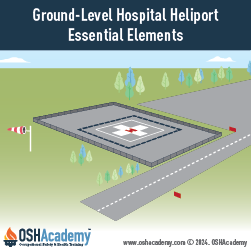Other Safety Considerations
There are many other things to be aware of while working around a helipad. Here are a few things:
- A safety area surrounding the final approach and takeoff area (FATO) should be clear of obstacles that are not required due to their function.
- Fixed objects within the safety area should not exceed a height of 8 inches (20 cm), nor should they penetrate the approach/departure surface.
- The helipad pavement should have a broomed or roughened finish that provides a skid-resistant surface for helicopters and non-slippery footing for workers and moving patients on gurneys.
- Hospital equipment, such as magnetic resonance imagers (MRI) machines, can interfere with a helicopter’s magnetic compass and other navigational systems. A warning sign alerting pilots to the presence of an MRI is recommended. Steps should also be taken to inform pilots of the location of MRI and similar equipment.
- A safety net, not less than 5 feet wide, should be provided when the touchdown and lift-off area (TLOF) is elevated more than 30 inches (76 cm) above the ground.
- A windsock should be used to provide pilots with valid wind direction and speed information in the heliport's vicinity. For night operation, the windsock should be illuminated to ensure it is clearly visible.
- If there is ever an accident on the helipad, do NOT put yourself in danger. Immediately activate the facility's emergency response system and activate the fire suppression system if a crash has occurred. Notify your hospital supervisor as soon as possible.
Knowledge Check Choose the best answer for the question.
1-6. Why is a warning sign alerting pilots to the presence of an MRI machine recommended?
You forgot to answer the question!

